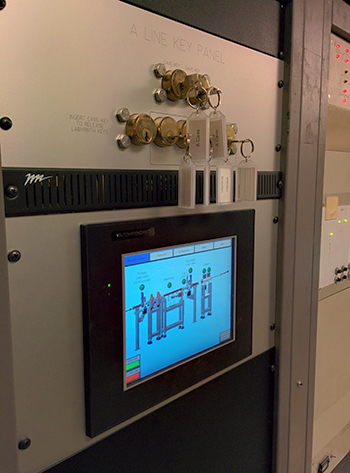Shiny new buttons at "A"

The old relay and L.E.D. system has been replaced with a hybrid system that mixes software and relay logic to provide core safety functions along with additional software control, protection and monitoring.

The old relay and L.E.D. system has been replaced with a hybrid system that mixes software and relay logic to provide core safety functions along with additional software control, protection and monitoring.
This is the preferred detector worldwide for macromolecular crystallography, because of its large dynamic range, zero background, very small point spread function, and millisecond readout time.
The two particle beams were the hallmark of the successful high-energy physics colliding beam program, but with those experiments finishing in 2008 x-ray production for CHESS became the primary mission of the laboratory. At that point source stability and flexibility became the top accelerator priority, driving the development of top-off injection that keeps the positron current constant at 200 milliamperes as well as a new slow-orbit feedback system that reduced x-ray beam source drifts to fewer than 10 microns.
To accommodate the very high heat load of this new, brighter source, the old swappable A2 monochromators have been retired, and replaced by a dedicated double-bounce diamond system behind a removable white-beam vertical-focus mirror. The front-end has been entirely rebuilt, and is now window-less from CESR all the way to the hutch. The new beamline is extremely versatile, delivering bright monochromatic x-ray beams at any incident energy between 5 keV and 70 keV.
Thanks to a little luck and a lot of clever engineering, the two, newly-installed canted undulators feed G-line without any modification to the G-line optics. This works because the two undulator beams, which are separated by 1 milliradian, fit almost perfectly within the much wider fan of radiation previously produced by the wiggler. With the wiggler installed, G2 and G3 shared the Northern half of the wiggler fan, while G1 used the Southern half.
The main activity focused on Walkalong Gliders where students and teachers designed and tested lightweight and slow flying model aircrafts. Erik Herman from Xraise was posed with questions about how the gliders worked, the type of materials used to make them and hypothetical questions about what would happen to the gliders in different environments. After making their gliders, the students got to test them around the room and improve on their design.
The workshop convened 6 speakers, all expert practitioners in various topics related to BioSAXS, who in a full first day of lectures, provided a solid foundation of the theory and application of solution X-ray scattering to an eager class with various industrial and academic appointments.
Melt bearing breccia samples were taken from the Mistastin impact structure, which was formed by a meteorite impact in Northern Labrador, Canada ~36 million years ago. Alaura is using XANES mapping to determine the phase and oxidation state of iron in glass clasts within the melt and in the surrounding matrix to determine the possibility of inclusion of meteoritic material in the melt.
Further commissioning activities and initial user science took place in June at bend-magnet station F3. General user science with the Maia detector began in earnest in October, in conjunction with a 48-hour workshop on the Maia detector and the software analysis package GeoPIXE. Twelve workshop attendees from eight unique user groups spent a day and a half reviewing critical XRF concepts and gaining hands-on experience with data analysis, accessing GeoPIXE on the central compute farm via their own PCs.
To understand this critical cellular process, biologists are studying the fine details of the structural changes involved, and how they are regulated. RNAP complexes vary from one species to another, but a core subset of proteins is found throughout archaeal and eukaryotic life forms. Comparison of archaeal and eukaryotic proteins reveals how structural motifs have been modified during evolution, so that function is maintained while regulation has become more complex in eukaryotic species.